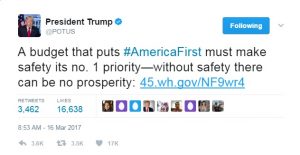President Donald Trump has submitted his first budget to Congress, an event many have been waiting for anxiously.  Candidate Trump, during the presidential campaign last fall, spoke frequently about reducing the size of the federal government and “draining the swamp” of Washington, so this budget was among his first emphatic statements in support of those pledges.
Candidate Trump, during the presidential campaign last fall, spoke frequently about reducing the size of the federal government and “draining the swamp” of Washington, so this budget was among his first emphatic statements in support of those pledges.
There is a lot to discuss about this FY18 budget, including the fact that virtually every Cabinet and other agency included in the budget – with the exception of Defense, Homeland Security, and Veterans Affairs – is seeing a decrease in funding from FY17 levels ranging from 1 percent (NASA) to 31 percent (EPA). There are my details still missing, however, as this is known as a “skinny budget,” typical of that submitted by first-term presidents who do not have much time to put the budget together. My particular and admittedly selfish interest is how this budget is likely to affect the nation’s roughly 4,600 degree-granting institutions of higher education. Here’s the spoiler, for those who don’t want to bother reading this entire post: The news is not good.
The U.S. Department of Education, the primary agency that provides funding for college and university students through the Title IV student aid programs, would see its overall funding reduced by $9.2 billion, or 13 percent, from the current year’s level of $68 billion if Congress enacts the President’s budget as submitted. The cuts that would directly impact higher education institutions and students include:
- Elimination of the Supplemental Educational Opportunity Grant program ($732 million), which provides grants to approximately 1.6 million low-income students each year.
- The College Work Study program, which subsidizes the wages provided to college students who work for their institution as a way of paying for college, would be reduced “significantly” (though no dollar amount was specified).
- The TRIO and GEAR UP programs, which provide college preparation and retention assistance to low-income and first-generation students both before college and while enrolled in college, would be cut by a total of almost $200 million.
- The Pell Grant program, which provides grants of up to almost $6,000 to over 7 million students per year, would see a $3.9 billion surplus (which could be used to fund students in future years) eliminated.
The impact of these cuts will be felt almost exclusively by students from low-income families. those who are most dependent on assistance from the federal government to help them attend college and persist through to a degree once enrolled. If enacted, and especially if they are continued into future years, these cuts will have a large and negative impact on this nation’s ability to increase postsecondary attainment rates, and they will serve to increase inequality between the poor and the rich in the nation.
This disproportionate impact on poor students is consistent with the Republican plan to replace the Affordable Care Act, announced last week. An analysis by The New York Times, which has been confirmed by other studies, has shown that it is lower-income families who are most likely to see their health care subsidies reduced under the Republican plan, which President Trump has supported, while wealthier families would see their subsidies increased.
A reduction in funding for the Department of Education is not the only item in the budget that will impact higher education. President Trump has also proposed to eliminate funding for the National Endowment for the Humanities and the National Endowment for the Arts, two agencies that provide many grants to faculty who work in these fields.
Funding for the National Institutes of Health (NIH) would be cut 20 percent under President Trump’s budget. The NIH is the largest funder of health-related research in the country, most of which is carried out at universities (including USF). Cutting this funding will likely hamper that research into preventing and curing disease, a critical national need particularly as our population ages.
And finally, the budget also shuts down the Corporation for National and Community Service (CNCS), home of the AmeriCorps program, which provides stipends and scholarships for many pre- and post-college students engaged in community service programs. This action would hit home particularly hard for us at USF, as we have a grant from CNCS to help operate the San Francisco Teacher Residency Program – which educates and certifies new teachers for the San Francisco Unified School District – in partnership with the district and Stanford University. Elimination of this program will reduce the supply of qualified and certified teachers in San Francisco.
As the budget works its way through Congress, it is likely that many of these line items will change. Particularly in the higher education realm, Congress has shown a willingness in the past to resurrect programs that were eliminated or cut by a president’s budget. But as submitted by President Trump, this budget is likely to have a very detrimental impact on higher education institutions and students in the United States.